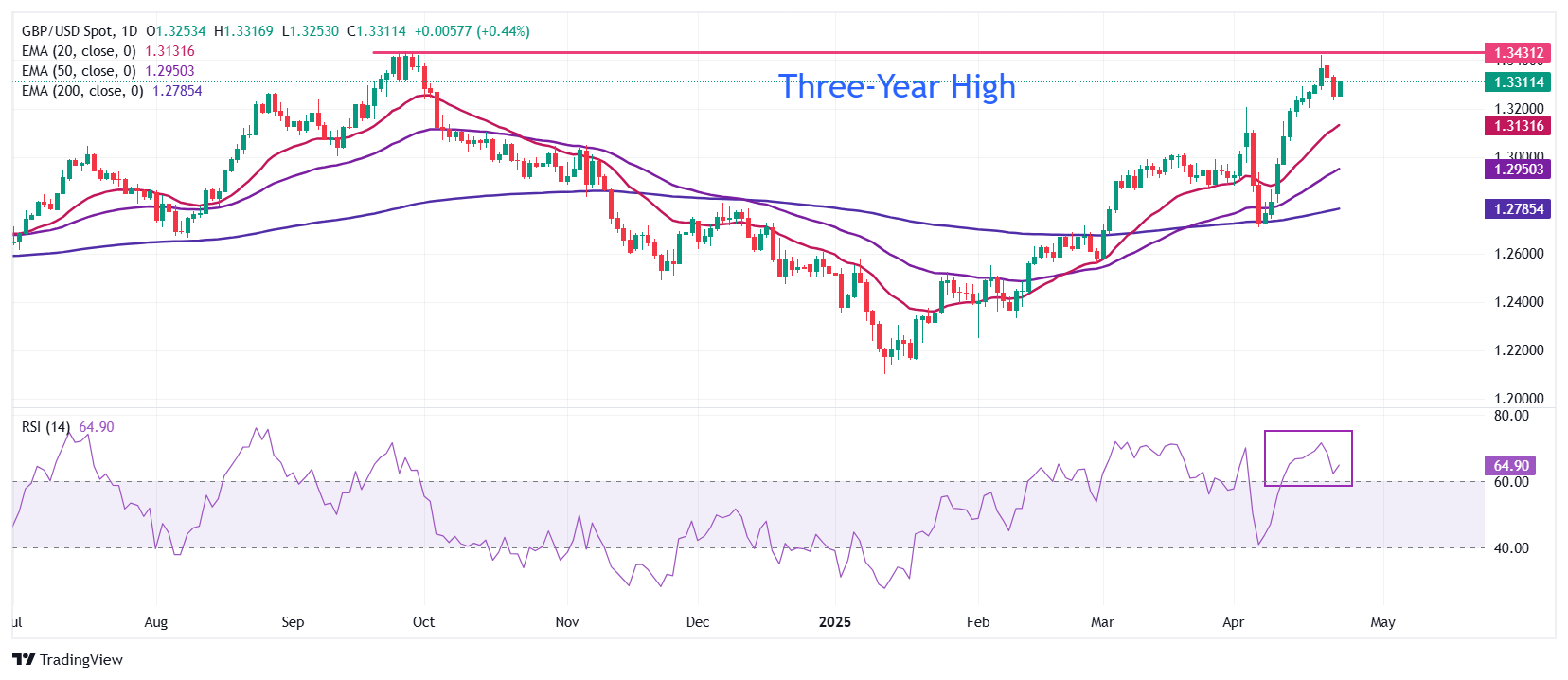Pound Sterling trades lower as BoE Bailey warns of trade war risk

- The Pound Sterling declines as BoE Bailey stresses that the central bank should take trade risk to growth very seriously.
- US Treasury Secretary Bessent hopes for a reduction in additional tariffs by both the US and China on each other.
- Investors await the US Durable Goods Orders and the UK Retail Sales data for March.
The Pound Sterling (GBP) drops against its peers, except North American currencies, on Thursday. The British currency faces pressure as investors turn cautious over the likely United Kingdom’s (UK) economic outlook in the face of tariffs announced by United States (US) President Donald Trump earlier this month.
Bank of England (BoE) Governor Andrew Bailey has expressed concerns over economic growth and stressed the need to consider trade war risk. “We do have to take very seriously the risk to growth,” Bailey said at the sidelines of the International Monetary Fund’s (IMF) spring meetings on Wednesday and added “We’re currently working through that because we’ve got an interest rate decision coming in two weeks’ time,” Reuters report. In the May policy meeting, traders are increasingly confident that the BoE will cut interest rates by 25 basis points (bps) to 4.25%.
For the remaining year, the IMF has anticipated three interest rate cuts by the BoE and has revised UK Gross Domestic Product (GDP) growth for 2025 to 1.1% from 1.6% projected earlier amid worries of global fallout due to Trump’s international policies, BBC News reported.
On the economic front, investors will focus on the United Kingdom (UK) Retail Sales data for March, which will be released on Friday. The Retail Sales data, a key measure of consumer spending, is expected to have declined by 0.4% month-on-month after rising by 1% in February. On year, the consumer spending measure is estimated to have risen at a moderate pace of 1.8% compared to the prior release of 2.2%.
British Pound PRICE Today
The table below shows the percentage change of British Pound (GBP) against listed major currencies today. British Pound was the strongest against the US Dollar.
| USD | EUR | GBP | JPY | CAD | AUD | NZD | CHF | |
|---|---|---|---|---|---|---|---|---|
| USD | -0.61% | -0.41% | -0.70% | -0.24% | -0.42% | -0.57% | -0.67% | |
| EUR | 0.61% | 0.20% | -0.11% | 0.37% | 0.17% | 0.03% | -0.06% | |
| GBP | 0.41% | -0.20% | -0.28% | 0.17% | -0.01% | -0.16% | -0.26% | |
| JPY | 0.70% | 0.11% | 0.28% | 0.45% | 0.29% | 0.09% | 0.07% | |
| CAD | 0.24% | -0.37% | -0.17% | -0.45% | -0.15% | -0.33% | -0.43% | |
| AUD | 0.42% | -0.17% | 0.01% | -0.29% | 0.15% | -0.15% | -0.25% | |
| NZD | 0.57% | -0.03% | 0.16% | -0.09% | 0.33% | 0.15% | -0.10% | |
| CHF | 0.67% | 0.06% | 0.26% | -0.07% | 0.43% | 0.25% | 0.10% |
The heat map shows percentage changes of major currencies against each other. The base currency is picked from the left column, while the quote currency is picked from the top row. For example, if you pick the British Pound from the left column and move along the horizontal line to the US Dollar, the percentage change displayed in the box will represent GBP (base)/USD (quote).
Daily digest market movers: Pound Sterling recovers against US Dollar
- The Pound Sterling bounces back to near 1.3300 against the US Dollar (USD) in Thursday’s European session. The GBP/USD pair rebounds after a two-day correction as the USD struggles to extend the recovery, with the US recovers to near 1.3300 against the US Dollar during European trading hours on Wednesday. The outlook of the pair remains firm as all short-to-long Exponential Moving Averages (EMAs) are sloping higher.
The 14-day Relative Strength Index (RSI) cools down to near 65.00 after turning overbought. This indicates a mild correction in the pair after a strong rally, but the upside trend is intact.
On the upside, the psychological level of 1.3500 will be a key hurdle for the pair. Looking down, the April 3 high around 1.3200 will act as a major support area.
Economic Indicator
Retail Sales (MoM)
The Retail Sales data, released by the Office for National Statistics on a monthly basis, measures the volume of sales of goods by retailers in Great Britain directly to end customers. Changes in Retail Sales are widely followed as an indicator of consumer spending. Percent changes reflect the rate of changes in such sales, with the MoM reading comparing sales volumes in the reference month with the previous month. Generally, a high reading is seen as bullish for the Pound Sterling (GBP), while a low reading is seen as bearish.
